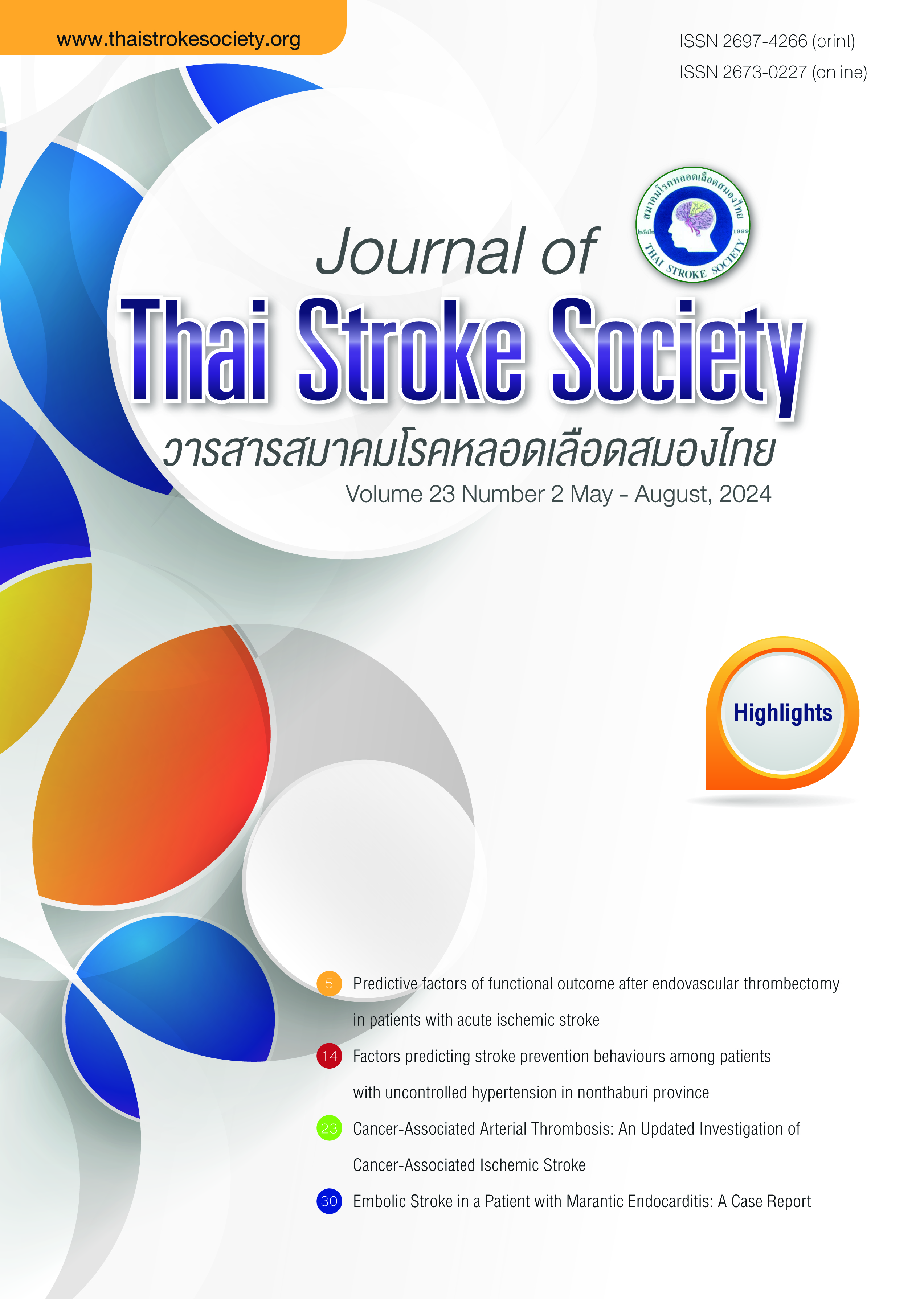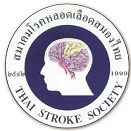Cancer-Associated Arterial Thrombosis: An Updated Investigation of Cancer-Associated Ischemic Stroke
Keywords:
Cancer-associated thrombosis, Cancer-associated ischemic stroke, Embolic stroke of undetermined source, D-dimer, FDG PET/CTAbstract
The recognition of cancer-associated ischemic stroke is increasing, shedding light on the previously overlooked problem of cancer-associated ESUS and its impact on late-stage cancer diagnoses. There is growing acknowledgment of the hypercoagulable state in cancer patients with ischemic stroke, with the risk of stroke significantly rising in the year preceding a cancer diagnosis, reaching its peak just before diagnosis. Several cancer types, with lung cancer being the most prevalent, are linked to cancer-associated ischemic stroke. The complex pathophysiology of this condition involves malignancy-related intravascular hypercoagulability, characterized by non-bacterial thrombotic endocarditis (NBTE) and paradoxical embolization as key mechanisms. The diagnostic work-up for stroke patients with cancer should include a standard etiological assessment, supplemented by an occult cancer detection protocol that encompasses various blood tests (especially D-dimer), imaging techniques, and Thoraco-Abdominal-Pelvic Computed Tomography (CT). Ongoing research explores the potential addition of FDG PET/CT to conventional cancer screening. Furthermore, a recent study investigating cancer-associated strokes introduced a machine learning-based prediction model utilizing immunohistochemically stained thrombi obtained during thrombectomy.
References
Selvik HA, Bjerkreim AT, Thomassen L, Waje-Andreassen U, Naess H, Kvistad CE. When to Screen Ischaemic Stroke Patients for Cancer. Cerebrovasc Dis. 2018;45(1-2):42-47. doi:10.1159/000484668
Navi BB, Reiner AS, Kamel H, et al. Arterial thromboembolic events preceding the diagnosis of cancer in older persons. Blood. 2019;133(8):781-789. doi:10.1182/blood-2018-06-860874
Kuo, HsunYu & Liu, Tsai-Wei & Huang, Yo-Ping & Chin, Shy-Chyi & Ro, Long-Sun & Choi, Sungwon. (2023). Differential Diagnostic Value of Machine Learning–Based Models for Embolic Stroke. Clinical and Applied Thrombosis/Hemostasis. 29. 10.1177/10760296231203663.
Chaturvedi S, Ansell J, Recht L. Should cerebral ischemic events in cancer patients be considered a manifestation of hypercoagulability?. Stroke. 1994;25(6):1215-18. doi:10.1161/01.str.25.6.1215
Finelli PF, Nouh A. Three-Territory DWI Acute Infarcts: Diagnostic Value in Cancer-Associated Hypercoagulation Stroke (Trousseau Syndrome). AJNR Am J Neuroradiol. 2016;37(11):2033-36. doi:10.3174/ajnr.A4846
Navi BB, Kasner SE, Elkind MSV, Cushman M, Bang OY, DeAngelis LM. Cancer and Embolic Stroke of Undetermined Source. Stroke. 2021;52(3):1121-30. doi:10.1161/STROKEAHA.120.032002
Graus F, Rogers LR, Posner JB. Cerebrovascular complications in patients with cancer. Medicine (Baltimore). 1985;64(1):16-35. doi:10.1097/00005792-198501000-00002
El-Shami K, Griffiths E, Streiff M. Nonbacterial thrombotic endocarditis in cancer patients: pathogenesis, diagnosis, and treatment. Oncologist. 2007;12(5):518-23. doi:10.1634/theoncologist.12-5-518
Cocho D, Gendre J, Boltes A, et al. Predictors of occult cancer in acute ischemic stroke patients. J Stroke Cerebrovasc Dis. 2015;24(6):1324-28. doi:10.1016/j.jstrokecerebrovasdis.2015.02.006
Beyeler M, Birner B, Branca M, et al. Development of a Score for Prediction of Occult Malignancy in Stroke Patients (Occult-5 Score). J Stroke Cerebrovasc Dis. 2022;31(8):106609. doi:10.1016/j.jstrokecerebrovasdis.2022.106609
Seystahl, K., Gramatzki, D., Wanner, M. et al. A risk model for prediction of diagnosis of cancer after ischemic stroke. Sci Rep 13, 111 (2023). https://doi.org/10.1038/s41598-022-26790-y
Hsu JY, Liu AB. Anticoagulants for cancer-associated ischemic stroke. Ci Ji Yi Xue Za Zhi. 2019;31(3):144-148. doi:10.4103/tcmj.tcmj_55_19
Kabrhel C, Mark Courtney D, Camargo CA Jr, et al. Factors associated with positive D-dimer results in patients evaluated for pulmonary embolism. Acad Emerg Med. 2010;17(6):589-97. doi:10.1111/j.1553-2712.2010.00765.x
Seok JM, Kim SG, Kim JW, et al. Coagulopathy and embolic signal in cancer patients with ischemic stroke. Ann Neurol. 2010;68(2):213-19. doi:10.1002/ana.22050
Hyung-Min Kwon, Bong Su Kang, Byung-Woo Yoon, Stroke as the first manifestation of concealed cancer, Journal of the Neurological Sciences, Volume 258, Issues 1–2, 2007, Pages 80-83, https://doi.org/10.1016/j.jns.2007.02.035.
Schwarzbach CJ, Fatar M, Eisele P, Ebert AD, Hennerici MG, Szabo K. DWI Lesion Patterns in Cancer-Related Stroke--Specifying the Phenotype. Cerebrovasc Dis Extra. 2015;5(3):139-45. Published 2015 Oct 30. doi:10.1159/000439549
Bang OY, Chung JW, Lee MJ, et al. Cancer-Related Stroke: An Emerging Subtype of Ischemic Stroke with Unique Pathomechanisms. J Stroke. 2020;22(1):1-10. doi:10.5853/jos.2019.02278
Carrier M, Le Gal G, Wells PS, Fergusson D, Ramsay T, Rodger MA. Systematic review: the Trousseau syndrome revisited: should we screen extensively for cancer in patients with venous thromboembolism?. Ann Intern Med. 2008;149(5):323-33. doi:10.7326/0003-4819-149-5-200809020-00007
Choi KH, Kim JH, Kim JM, et al. d-dimer Level as a Predictor of Recurrent Stroke in Patients With Embolic Stroke of Undetermined Source. Stroke. 2021;52(7):2292-2301. doi:10.1161/STROKEAHA.120.033217
Heo J, Lee H, Seog Y, et al. Cancer Prediction With Machine Learning of Thrombi From Thrombectomy in Stroke: Multicenter Development and Validation. Stroke. 2023;54(8):2105-13. doi:10.1161/STROKEAHA.123.043127
Downloads
Published
How to Cite
Issue
Section
License
Copyright (c) 2024 Journal of Thai Stroke Society

This work is licensed under a Creative Commons Attribution-NonCommercial-NoDerivatives 4.0 International License.
ข้อความภายในบทความที่ตีพิมพ์ในวารสารสมาคมโรคหลอดเลือดสมองไทยเล่มนี้ ตลอดจนความรับผิดชอบด้านเนื้อหาและการตรวจร่างบทความเป็นของผู้นิพนธ์ ไม่เกี่ยวข้องกับกองบรรณาธิการแต่อย่างใด การนำเนื้อหา ข้อความหรือข้อคิดเห็นของบทความไปเผยแพร่ ต้องได้รับอนุญาตจากกองบรรณาธิการอย่างเป็นลายลักษณ์อักษร ผลงานที่ได้รับการตีพิมพ์ในวารสารเล่มนี้ถือเป็นลิขสิทธิ์ของวารสาร





